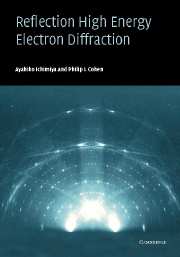Book contents
- Frontmatter
- Contents
- Preface
- 1 Introduction
- 2 Historical survey
- 3 Instrumentation
- 4 Wave properties of electrons
- 5 The diffraction conditions
- 6 Geometrical features of the pattern
- 7 Kikuchi and resonance patterns
- 8 Real diffraction patterns
- 9 Electron scattering by atoms
- 10 Kinematic electron diffraction
- 11 Fourier components of the crystal potential
- 12 Dynamical theory – transfer matrix method
- 13 Dynamical theory – embedded R-matrix method
- 14 Dynamical theory – integral method
- 15 Structural analysis of crystal surfaces
- 16 Inelastic scattering in a crystal
- 17 Weakly disordered surfaces
- 18 Strongly disordered surfaces
- 19 RHEED intensity oscillations
- Appendix A: Fourier representations
- Appendix B: Green's functions
- Appendix C: Kirchhoff's diffraction theory
- Appendix D: A simple eigenvalue problem
- Appendix E: Waller and Hartree equation
- Appendix F: Optimization of dynamical calculation
- Appendix G: Scattering factor
- References
- Index
19 - RHEED intensity oscillations
Published online by Cambridge University Press: 06 July 2010
- Frontmatter
- Contents
- Preface
- 1 Introduction
- 2 Historical survey
- 3 Instrumentation
- 4 Wave properties of electrons
- 5 The diffraction conditions
- 6 Geometrical features of the pattern
- 7 Kikuchi and resonance patterns
- 8 Real diffraction patterns
- 9 Electron scattering by atoms
- 10 Kinematic electron diffraction
- 11 Fourier components of the crystal potential
- 12 Dynamical theory – transfer matrix method
- 13 Dynamical theory – embedded R-matrix method
- 14 Dynamical theory – integral method
- 15 Structural analysis of crystal surfaces
- 16 Inelastic scattering in a crystal
- 17 Weakly disordered surfaces
- 18 Strongly disordered surfaces
- 19 RHEED intensity oscillations
- Appendix A: Fourier representations
- Appendix B: Green's functions
- Appendix C: Kirchhoff's diffraction theory
- Appendix D: A simple eigenvalue problem
- Appendix E: Waller and Hartree equation
- Appendix F: Optimization of dynamical calculation
- Appendix G: Scattering factor
- References
- Index
Summary
RHEED intensity oscillations are now routinely used for measuring growth rates during molecular beam epitaxy. They are used to determine whether the growth mode is via island nucleation or step flow, whether growth occurs in layer or bilayer growth modes and to obtain estimates of surface diffusion. But little use has been made of quantitative measurements of the damping or of the strong angular dependence. RHEED oscillations are widely believed to be related to step density and to have strong path-length interference components. The main difficulty in separating these two mechanisms is that dynamical calculation from a disordered surface, with distributions of islands and adatoms randomly arranged at surface lattice sites, is exceedingly difficult. Our assessment and the topic for discussion in this chapter is that, depending upon the predominant island sizes, different mechanisms can dominate. We argue that step density, kinematic calculations and shadowing arguments are each inadequate to explain all the measured angular dependences and wave forms. The intensity oscillations measured with RHEED are fundamentally a dynamical effect, and each of the mechanisms contributes various aspects. Nonetheless, it appears that the coverages of the layers that comprise the growth front are the major factor producing the intensity oscillations. From a practical point of view, these measurements are at least as important as symmetry and structural determinations. In this chapter we examine their diverse characteristics from the various points of view in a variety of systems.
- Type
- Chapter
- Information
- Reflection High-Energy Electron Diffraction , pp. 270 - 313Publisher: Cambridge University PressPrint publication year: 2004

